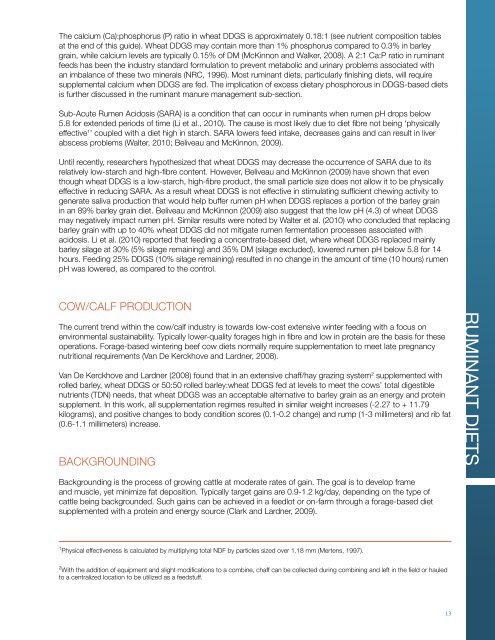Wheat DDGS Feed Guide - Western Canadian Feed Innovation ...
Wheat DDGS Feed Guide - Western Canadian Feed Innovation ...
Wheat DDGS Feed Guide - Western Canadian Feed Innovation ...
Create successful ePaper yourself
Turn your PDF publications into a flip-book with our unique Google optimized e-Paper software.
The calcium (Ca):phosphorus (P) ratio in wheat <strong>DDGS</strong> is approximately 0.18:1 (see nutrient composition tables<br />
at the end of this guide). <strong>Wheat</strong> <strong>DDGS</strong> may contain more than 1% phosphorus compared to 0.3% in barley<br />
grain, while calcium levels are typically 0.15% of DM (McKinnon and Walker, 2008). A 2:1 Ca:P ratio in ruminant<br />
feeds has been the industry standard formulation to prevent metabolic and urinary problems associated with<br />
an imbalance of these two minerals (NRC, 1996). Most ruminant diets, particularly finishing diets, will require<br />
supplemental calcium when <strong>DDGS</strong> are fed. The implication of excess dietary phosphorous in <strong>DDGS</strong>-based diets<br />
is further discussed in the ruminant manure management sub-section.<br />
Sub-Acute Rumen Acidosis (SARA) is a condition that can occur in ruminants when rumen pH drops below<br />
5.8 for extended periods of time (Li et al., 2010). The cause is most likely due to diet fibre not being ‘physically<br />
effective 1 ’ coupled with a diet high in starch. SARA lowers feed intake, decreases gains and can result in liver<br />
abscess problems (Walter, 2010; Beliveau and McKinnon, 2009).<br />
Until recently, researchers hypothesized that wheat <strong>DDGS</strong> may decrease the occurrence of SARA due to its<br />
relatively low-starch and high-fibre content. However, Beliveau and McKinnon (2009) have shown that even<br />
though wheat <strong>DDGS</strong> is a low-starch, high-fibre product, the small particle size does not allow it to be physically<br />
effective in reducing SARA. As a result wheat <strong>DDGS</strong> is not effective in stimulating sufficient chewing activity to<br />
generate saliva production that would help buffer rumen pH when <strong>DDGS</strong> replaces a portion of the barley grain<br />
in an 89% barley grain diet. Beliveau and McKinnon (2009) also suggest that the low pH (4.3) of wheat <strong>DDGS</strong><br />
may negatively impact rumen pH. Similar results were noted by Walter et al. (2010) who concluded that replacing<br />
barley grain with up to 40% wheat <strong>DDGS</strong> did not mitigate rumen fermentation processes associated with<br />
acidosis. Li et al. (2010) reported that feeding a concentrate-based diet, where wheat <strong>DDGS</strong> replaced mainly<br />
barley silage at 30% (5% silage remaining) and 35% DM (silage excluded), lowered rumen pH below 5.8 for 14<br />
hours. <strong>Feed</strong>ing 25% <strong>DDGS</strong> (10% silage remaining) resulted in no change in the amount of time (10 hours) rumen<br />
pH was lowered, as compared to the control.<br />
COW/CALF PRODUCTION<br />
The current trend within the cow/calf industry is towards low-cost extensive winter feeding with a focus on<br />
environmental sustainability. Typically lower-quality forages high in fibre and low in protein are the basis for these<br />
operations. Forage-based wintering beef cow diets normally require supplementation to meet late pregnancy<br />
nutritional requirements (Van De Kerckhove and Lardner, 2008).<br />
Van De Kerckhove and Lardner (2008) found that in an extensive chaff/hay grazing system 2 supplemented with<br />
rolled barley, wheat <strong>DDGS</strong> or 50:50 rolled barley:wheat <strong>DDGS</strong> fed at levels to meet the cows’ total digestible<br />
nutrients (TDN) needs, that wheat <strong>DDGS</strong> was an acceptable alternative to barley grain as an energy and protein<br />
supplement. In this work, all supplementation regimes resulted in similar weight increases (-2.27 to + 11.79<br />
kilograms), and positive changes to body condition scores (0.1-0.2 change) and rump (1-3 millimeters) and rib fat<br />
(0.6-1.1 millimeters) increase.<br />
BACKGROUNDING<br />
Backgrounding is the process of growing cattle at moderate rates of gain. The goal is to develop frame<br />
and muscle, yet minimize fat deposition. Typically target gains are 0.9-1.2 kg/day, depending on the type of<br />
cattle being backgrounded. Such gains can be achieved in a feedlot or on-farm through a forage-based diet<br />
supplemented with a protein and energy source (Clark and Lardner, 2009).<br />
1 Physical effectiveness is calculated by multiplying total NDF by particles sized over 1.18 mm (Mertens, 1997).<br />
2 With the addition of equipment and slight modifications to a combine, chaff can be collected during combining and left in the field or hauled<br />
to a centralized location to be utilized as a feedstuff.<br />
13<br />
RUMINANT DIETS


